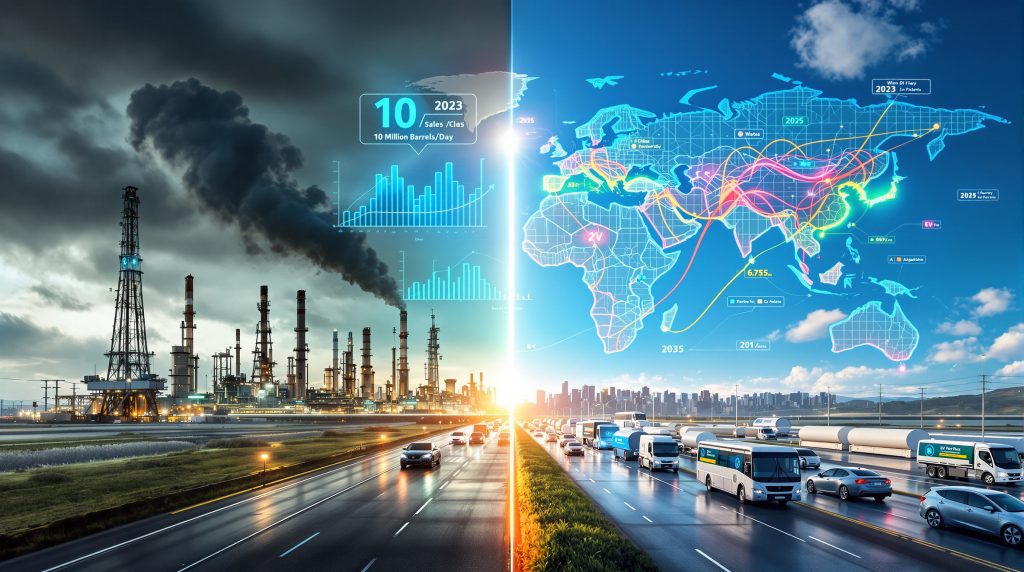Understanding the Scale of Electric Vehicle Oil Displacement by 2035
The transportation sector faces unprecedented transformation as electric vehicles accelerate toward mainstream adoption. According to the International Energy Agency's World Energy Outlook 2025, EVs to displace 10mn b/d of oil by 2035 under their Stated Policies Scenario, representing approximately 10% of current global petroleum consumption.
This projection reflects a dramatic shift in mobility patterns, with electric vehicle market share expanding from 25% in 2025 to over 50% by 2035. The displacement encompasses all vehicle categories, from passenger cars to commercial trucks, creating cascading effects throughout petroleum markets and refining operations.
Global EV Market Transformation Timeline
| Year | Daily Oil Displacement (Million Barrels) | Global EV Fleet (Million Units) | Market Share % |
|---|---|---|---|
| 2025 | 1.8 | 20.0 | 25% |
| 2030 | 5.2 | 280.0 | 38% |
| 2035 | 10.0 | 840.0 | 52% |
Source: IEA World Energy Outlook 2025, STEPS scenario
The scale becomes clearer when considering that 840 million electric vehicles will populate roads globally by 2035, compared to roughly 40 million today. Furthermore, this six-fold expansion creates the foundation for unprecedented petroleum demand destruction across transportation sectors.
Additional displacement contributors include hybrid technologies and biofuel adoption, which collectively save another 4.9 million barrels daily. Combined with full electrification, total fossil fuel displacement approaches 15 million barrels per day by the mid-2030s, significantly impacting the EV mining impact.
Which Vehicle Categories Drive the Largest Oil Demand Reductions?
Light-Duty Vehicle Electrification Impact
Passenger transportation dominates oil displacement projections, accounting for approximately 65% of the 10 million barrel reduction. Modern battery-electric vehicles achieve energy consumption rates of 25-30 kWh per 100 kilometers, equivalent to displacing roughly 2.8 litres of gasoline over the same distance.
China leads this transformation with projected sales of 14 million EVs in 2025 alone. Chinese automakers are expanding globally by introducing 10 new affordable models priced under €25,000, making electric mobility accessible to broader consumer segments previously limited by cost barriers.
Light-Duty Displacement Drivers:
- Model availability expansion: Over 300 EV models available globally in 2025 versus 45 in 2015
- Price competitiveness: Battery costs declined 85% between 2010-2024, enabling vehicle price parity
- Charging infrastructure maturity: Public charging networks expanded 400% since 2020
- Total cost of ownership advantages: Operational savings of $3,200-4,800 annually per vehicle
Brazil demonstrates emerging market adoption patterns, with Chinese EVs capturing 85% of electric vehicle sales in 2024. The country doubled EV sales year-over-year, driven primarily by economic advantages rather than environmental preferences.
Commercial Fleet Transformation
Commercial vehicle electrification represents the fastest-growing displacement segment, with fleet operators prioritising total cost of ownership optimisation. Electric buses contribute approximately 1.8 million barrels daily of reduced petroleum demand, while freight electrification adds another 2.1 million barrels.
Commercial Vehicle Displacement Breakdown:
- Urban delivery fleets: 1.9 million b/d
- Long-haul trucking: 2.1 million b/d
- Public transit systems: 1.8 million b/d
- Two/three-wheelers: 0.9 million b/d
- Service and utility vehicles: 1.3 million b/d
Electric buses demonstrate particular displacement efficiency due to predictable routes, centralised charging, and high daily mileage. Urban transit agencies report maintenance cost reductions of 60% compared to diesel counterparts, accelerating fleet replacement cycles.
Two-wheeler electrification drives displacement in Asian markets, where electric models now account for over 40% of total auto sales in Vietnam. These vehicles offer compelling economics for urban mobility while requiring minimal charging infrastructure investment.
How Do Regional Markets Shape Global Displacement Patterns?
Asia-Pacific Leadership in Displacement Volume
The Asia-Pacific region generates approximately 6.2 million barrels daily of the projected 10 million barrel displacement, with China accounting for nearly 4.1 million barrels alone. This dominance reflects aggressive electrification policies, manufacturing scale advantages, and urban air quality mandates driving adoption.
Chinese battery production capacity enables competitive pricing across all vehicle categories, with government support mechanisms including purchase subsidies, licensing preferences, and preferential grid access. Manufacturing cost advantages allow Chinese automakers to export competitively-priced vehicles to markets including Brazil, Costa Rica, Uruguay, and Colombia.
Southeast Asian Contribution Patterns:
- Thailand: 420,000 b/d displacement primarily from two-wheeler electrification
- Indonesia: 380,000 b/d focused on three-wheeler commercial applications
- Vietnam: 340,000 b/d driven by electric motorcycle adoption exceeding 40% market share
- Malaysia: 280,000 b/d from government fleet procurement mandates
Vietnam's electric two and three-wheeler market demonstrates how regional transportation patterns influence displacement profiles. Electric motorcycles and rickshaws achieve faster adoption rates than four-wheelers due to lower absolute costs and existing usage patterns.
European Market Maturation Effects
European Union countries contribute approximately 2.7 million barrels daily of oil displacement by 2035, driven by comprehensive regulatory frameworks including internal combustion engine phase-out timelines and zero-emission zone implementations.
Norway, Netherlands, and Germany lead per-capita displacement rates through early adoption support and charging infrastructure density. Norway's 28,000 public charging points create the world's highest per-capita charging availability, while Germany targets 1.1 million charging points by 2030.
European Policy Acceleration Mechanisms:
- EU Fit for 55 package: Targets 55% emissions reduction by 2030
- ICE ban implementation: Effective 2035 for new passenger vehicle registrations
- Zero-emission zones: Major urban centres restrict internal combustion vehicles
- Alternative Fuels Infrastructure Regulation: Mandates 1 public charger per 10 EVs
Southern European markets accelerate adoption as charging infrastructure expands and vehicle costs decline. Moreover, Spain and Italy show particular growth in commercial fleet electrification, driven by logistics companies optimising urban delivery operations.
North American Transition Dynamics
United States EV adoption faces significant policy volatility affecting displacement projections. The IEA revised 2035 US EV sales forecasts downward by 60% compared to 2024 projections, from 11 million to 4.4 million units, following implementation of the One Big Beautiful Bill Act cutting EV tax and monetary benefits.
US EV sales declined 4% in the first half of 2025, contrasting with growth patterns in other major markets. This policy shift reduces projected US oil displacement from approximately 2.8 million to 1.2 million barrels daily by 2035.
State-Level Counterbalance Mechanisms:
- California Zero Emission Vehicle program: Requires 100% zero-emission new car sales by 2035
- New York transition requirements: Independent state-level EV mandates
- Massachusetts percentage requirements: Increasingly stringent targets through 2030s
- Multi-state transportation initiatives: Regional cooperation on charging corridors
State-level regulatory frameworks maintain market momentum despite federal policy changes. California alone represents approximately 25% of US EV market share and maintains independent regulatory authority through established precedents.
What Economic Forces Accelerate Oil Displacement Through EVs?
Total Cost of Ownership Advantages
Economic factors now dominate EV adoption decisions, with operational costs averaging 60-70% below equivalent gasoline vehicles. Fleet operators, particularly ride-share services, report average savings of $3,500-4,200 annually per vehicle, creating compelling business cases for electrification.
Brazilian ride-share drivers demonstrate real-world economics, saving approximately R2,500 monthly ($465) compared to gasoline vehicles. These savings result primarily from energy cost differentials rather than maintenance advantages, though both contribute to total cost optimisation.
Operational Cost Comparison Analysis:
- Energy costs: EVs 2.8-4.2 cents/km vs ICE 9.1-13.5 cents/km
- Maintenance: EVs 1.8 cents/km vs ICE 6.4 cents/km
- Insurance: Generally comparable with slight 5-8% EV premiums
- Depreciation: Converging rapidly as markets mature
- Financing: Increasingly favourable rates for electric vehicles
Electric vehicles have achieved price parity with several best-selling gasoline models in Brazil, eliminating purchase price barriers that previously limited adoption. Consequently, this parity, combined with operational advantages, shifts decision-making from environmental preference to financial optimisation.
Manufacturing Scale Economics
Battery production cost reductions enable continued vehicle price competitiveness across all segments. Costs declined 85% between 2010-2024, with projections for additional 35-40% reductions by 2030 as manufacturing scales expand globally.
Chinese battery production capacity dominates global supply chains, controlling 60-80% of critical mineral processing. This concentration creates both cost advantages and supply chain dependencies that influence regional displacement patterns, driving battery metals investment strategies.
Technology Cost Trajectory:
- Battery pack costs: $132/kWh in 2024, targeting $70/kWh by 2030
- Manufacturing capacity: Global battery production reaching 2,000 GWh by 2030
- Charging infrastructure: Installation costs declined 40% since 2020
- Power electronics: Efficiency improvements reducing system costs 25%
Solid-state battery development accelerates performance advantages while potentially increasing nickel and lithium demand. Chinese manufacturers including Beijing Easpring Material Technology deliver cathode materials for batteries exceeding 400Wh/kg energy density, far surpassing current liquid battery specifications, supporting battery-grade lithium refinery developments.
How Will Oil Markets Adapt to 10 Million Barrel Demand Loss?
Refining Sector Restructuring
Global refining capacity faces oversupply pressures as gasoline demand peaks around 2030 and begins structural decline. European and North American refineries show particular vulnerability, with 18-25 facilities potentially facing closure or conversion by 2035.
Diesel demand demonstrates more resilience due to slower heavy-duty vehicle electrification, creating product slate imbalances requiring operational adjustments. Refiners increasingly focus on petrochemical feedstock production and sustainable aviation fuel processing to maintain throughput optimisation.
Refining Adaptation Strategies:
- Facility conversions: Gasoline units converted to diesel and jet fuel production
- Petrochemical integration: Increased focus on chemical feedstock production
- Biofuel processing: Renewable diesel and sustainable aviation fuel capacity
- Regional consolidation: Closure of high-cost, inefficient facilities
Upstream Production Implications
Oil producers face differentiated impacts based on production cost structures and resource quality. High-cost unconventional sources experience displacement pressure first, while low-cost Middle Eastern production retains market share through competitive advantages, according to the IEA's latest analysis.
Production Impact Hierarchy:
- High-cost unconventional sources: First displacement pressure from reduced demand growth
- Medium-cost conventional fields: Maintained viability through operational optimisation
- Low-cost Middle Eastern production: Market share gains through competitive positioning
- Strategic petroleum reserves: Increased relative importance for supply security
Investment patterns shift toward remaining growth segments including aviation fuel, petrochemicals, and marine bunker fuels. Upstream operators increasingly focus on low-cost resource development while high-cost projects face reduced investment attractiveness.
Which Supporting Technologies Amplify EV Oil Displacement?
Hybrid Technology Contributions
Plug-in hybrid vehicles contribute an additional 2.8 million barrels daily of oil displacement by 2035, particularly valuable in markets where charging infrastructure remains limited or long-distance travel requirements favour range flexibility.
Advanced hybrid systems achieve 45-65% fuel consumption reductions compared to conventional vehicles, providing transitional displacement benefits while full electrification infrastructure develops. Brazil's Volkswagen plans focus on flex-fuel hybrid development, enabling operation with gasoline or ethanol while incorporating electric assistance.
Hybrid Displacement Advantages:
- Infrastructure flexibility: Reduced dependence on charging network density
- Range optimisation: Long-distance capability without charging stops
- Fuel flexibility: Compatibility with renewable fuel blends
- Cost positioning: Lower purchase prices than full battery-electric vehicles
Battery Technology Acceleration
Solid-state battery development creates opportunities for enhanced displacement through improved performance characteristics. Chinese manufacturers accelerate development timelines, with Chery's Rhino S module achieving 600Wh/kg energy density supporting driving ranges exceeding 1,200 kilometres.
Ultra-high nickel precursors enable improved energy density, lifecycle performance, and safety characteristics in solid-state applications. Sunwoda's polymer all-solid-state battery reaches 400Wh/kg energy density, while laboratory samples achieve 520Wh/kg through lithium-metal super battery configurations.
Technology Development Timeline:
- 2025-2027: Initial vehicle assembly and verification testing
- 2027-2030: Limited production and premium market introduction
- 2030-2035: Mass production scaling and mainstream market adoption
- Post-2035: Full market penetration across all vehicle segments
Manufacturing cost challenges initially limit solid-state battery adoption, with industry participants noting that most consumers cannot afford high initial costs. However, continued scale development projects significant cost reductions enabling broader market access by the early 2030s, potentially boosting battery recycling breakthrough initiatives.
What Infrastructure Requirements Support 10 Million Barrel Displacement?
Charging Network Scaling Needs
Supporting 840 million electric vehicles globally requires approximately 84 million public charging points by 2035, representing eight-fold expansion from current installation levels. Fast-charging networks require particular scaling to enable long-distance travel and commercial fleet operations.
Brazil's charging infrastructure demonstrates emerging market development patterns, with Tupinambá Energia managing 1,500 of approximately 17,000 public charging points. The country maintains an 18:1 EV-to-charger ratio, above the IEA benchmark of 10:1, indicating infrastructure deficit requiring continued investment.
Infrastructure Investment Requirements:
- Public charging stations: $220 billion globally through 2035
- Grid capacity upgrades: $280 billion for transmission and distribution
- Manufacturing facility expansion: $380 billion across battery and vehicle production
- Raw material supply chains: $180 billion for mining and processing capacity
DC fast-charging infrastructure grows at 10% monthly in Brazil, while AC chargers expand 14% over comparable periods. This growth pattern reflects investment economics favouring fast-charging installations for public applications.
Electricity Generation Implications
Transportation electrification adds approximately 3,800 TWh of annual electricity demand by 2035, equivalent to 16% of current global generation. Renewable energy expansion becomes critical for maintaining emissions benefits and energy security objectives.
Brazil's clean energy matrix provides competitive advantages for EV adoption, with hydroelectric and renewable sources enabling low-cost charging. The country's energy matrix compares favourably to other major markets, supporting economic arguments for electric mobility transition and enhancing critical minerals energy transition opportunities.
Grid Integration Challenges:
- Peak demand management: Vehicle charging coordination with grid optimisation
- Renewable intermittency: Energy storage requirements for grid stability
- Distribution upgrades: Local infrastructure capacity for charging concentrations
- Smart charging systems: Demand response integration for grid efficiency
Low-voltage to high-voltage conversion creates bottlenecks for charging infrastructure scaling. This process requires up to six months in certain regions, creating deployment delays particularly affecting fast-charging installations requiring higher voltage levels.
How Do Geopolitical Factors Influence Displacement Timelines?
Critical Mineral Dependencies
Lithium, cobalt, nickel, and rare earth element supply chains create geopolitical considerations as transportation electrification scales. China controls 60-80% of critical mineral processing capacity, generating strategic dependencies for Western markets pursuing electrification objectives.
Supply concentration risks influence displacement timelines through potential bottlenecks constraining battery production. Alternative supply chain development becomes essential for sustained displacement growth, particularly for markets seeking supply chain diversification.
Critical Mineral Vulnerabilities:
- Lithium processing: 70% concentrated in China, Chile, and Australia
- Cobalt mining: 60% sourced from Democratic Republic of Congo
- Nickel production: Indonesia and Philippines dominate low-cost supply
- Rare earth elements: 85% processing capacity located in China
Trade Policy Impacts
Tariffs, import restrictions, and technology transfer limitations affect electric vehicle cost competitiveness across different markets. Recent US policy changes demonstrate displacement projection volatility based on international trade relationships.
The One Big Beautiful Bill Act exemplifies policy impact on displacement timelines, cutting EV sales and battery production benefits. This policy shift prompted the IEA to reduce US 2035 EV projections by 60%, from 11 million to 4.4 million units.
Policy Risk Factors:
- Import tariff modifications: Direct impact on vehicle cost competitiveness
- Technology transfer restrictions: Constraints on advanced battery technology access
- Investment incentive changes: Affecting manufacturing location decisions
- International trade agreements: Bilateral arrangements influencing market access
Emerging markets benefit from Chinese EV export competitiveness, with affordable models priced under €25,000 reshaping automotive markets in Brazil, Costa Rica, Uruguay, and Colombia.
What Investment Opportunities Emerge from Oil Displacement Trends?
Battery Technology and Manufacturing
Energy storage advancement drives cost reductions and performance improvements essential for sustained adoption growth. Solid-state batteries, improved recycling processes, and alternative chemistries represent high-growth investment segments with long-term market potential.
Beijing Easpring Material Technology demonstrates commercial-scale opportunities, delivering over 20 tonnes per order of cathode materials for all-solid-state batteries. The company doubled cathode production to 73,133 tonnes in first-half 2025, expanding globally with manufacturing facilities in Finland.
Investment Focus Areas:
- Battery chemistry development: Solid-state and advanced lithium technologies
- Manufacturing automation: Production scale and cost optimisation
- Recycling infrastructure: End-of-life battery material recovery
- Supply chain integration: Vertical integration from mining to battery production
Charging Infrastructure Development
Public and private charging network expansion requires substantial capital investment with attractive returns in growing markets. Fast-charging corridor development, workplace installations, and residential solutions offer differentiated investment opportunities.
Tupinambá Energia's Brazilian operations demonstrate market potential, with 230,000 registered users completing over 1.3 million charging sessions consuming 26 GWh of energy. The platform's growth reflects underlying demand for charging service accessibility and reliability.
Infrastructure Investment Categories:
- Urban fast-charging networks: High-utilisation locations with premium pricing
- Highway corridor development: Long-distance travel enablement
- Workplace charging: Employee benefit programmes and fleet applications
- Residential charging solutions: Home installation and management systems
Automotive Industry Transformation
Traditional automakers face transition challenges while new market entrants capture growing segments. Investment opportunities span vehicle manufacturing, technology development, and supporting service industries throughout the value chain.
Stellantis' circular economy initiatives demonstrate emerging business models, with automotive dismantling facilities processing 8,000 vehicles annually. The company recovers 450kg of steel and 50kg of aluminium per vehicle while generating revenue through certified parts sales.
Automotive Investment Themes:
- Electric vehicle manufacturing: Production capacity expansion and technology integration
- Autonomous driving systems: Software and sensor technology development
- Vehicle-to-grid integration: Energy storage and grid services applications
- Mobility services: Ride-sharing, delivery, and fleet management platforms
Vehicle dismantling and recycling creates investment opportunities in circular economy applications. Stellantis recovers approximately 5,000 tonnes annually of materials including ferrous scrap, aluminium, copper, and various fluids while ensuring legal compliance and quality certification.
Investment Disclaimer: Electric vehicle market projections involve significant uncertainties including policy changes, technology development timelines, and competitive dynamics. Investors should conduct thorough due diligence and consider multiple scenarios when evaluating opportunities in this rapidly evolving sector.
The displacement of EVs to displace 10mn b/d of oil by 2035 represents one of the most significant energy market transitions in modern history, creating both challenges and opportunities across multiple industries. Success in capturing these opportunities requires understanding regional dynamics, technology development timelines, and policy evolution affecting market development patterns. Research from S&P Global Commodity Insights confirms these projections, highlighting the substantial impact this transformation will have on global petroleum markets.
Looking to Capitalise on Electric Vehicle Mining Opportunities?
The transition to 840 million electric vehicles by 2035 will drive unprecedented demand for critical minerals like lithium, nickel, and cobalt. Discovery Alert's proprietary Discovery IQ model delivers real-time alerts on significant ASX mineral discoveries, instantly empowering subscribers to identify actionable opportunities in the battery metals sector ahead of the broader market. Begin your 30-day free trial today and position yourself ahead of this transformative energy transition.




